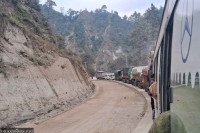Opinion
Harnessing wind energy
The government must accept the essential role of energy, especially green energy
Khilendra Basnyat
Wind is a form of green, non-renewable energy created by the sun. It is the reaction of the atmosphere to the incoming energy from the sun, as in: the presence of heat causes low pressure areas, whereas the lack of it results in high pressure. This process causes air to blow from high pressure areas to low ones, which can be harnessed and utilised as energy. It has been estimated that about 80 percent of the world’s energy comes from fossil fuels, 20 percent from dung and vegetable refuse, one percent from water power, mainly through hydroelectricity, and the remaining from nuclear, geothermal and wind power, combined. This means the amount of green energy being utilised globally is very less.
Wind energy does not introduce any waste into the biosphere, but it is not a constant, and/or predictable, source of energy as the sun. Despite this, its energy can be harnessed and saved in a storage system designed to make the energy available at the time it is needed. In today’s world, energy crisis is a burning issue. Many countries, especially developing ones, have been facing the problem of a lack of energy resources and fear the situation will only worsen in the coming years.
However, there is tremendous scope for planning energy utilisation in this world. Some controlling factors regarding energy policies depend on voluntary decisions of individuals and government actions that may restrict an individual’s freedom. However, both economic and technical questions of feasibility depend on the priority and the magnitude of the efforts applied. A propeller-driven turbine can convert wind energy into electricity, with an efficiency ranging from 60 to 80 percent. Using a green energy source such as wind can help not just combat energy crisis but also mitigate climate change. However, utilising wind energy is not an easy job because it is the most inconsistent form of energy. It is possible to extract such energy only from a power plant which has a reasonably steady output. But such a practical storage medium has not yet been developed, and electric storage batteries are out of the question.
Until now, wind power has been used only where other sources of power are not available or are highly expensive. Moreover, the use of wind to produce mechanical or electrical power depends critically on whether or not it is necessary to have the power output during any specified time.
Windmills, used to pump water for farms or homes, can store energy by raising water into elevated tanks, whence it and its potential energy can be withdrawn when required. In windy areas, windmills can be widely used to works that do not require the mills to turn constantly. Grinding grains and draining polders are two examples of such mills. Winds in general are erratic and undependable. But in isolated windy localities, where any alternative form of energy would be more expensive, windmills can be used to generate electric power, and the surplus can be stored in batteries.
In least developed countries like ours, where people struggle every day to put food on the table, there aren’t enough resources available to transition our country from using non-renewable energies, like fuel, to using green energy, like wind. In order to provide the people of the world with a good quality of life, governments must accept the essential role of energy, particularly green energy. Nepal has a high potential for harnessing wind energy. Apart from the Tarai, districts like Mustang, Khumbu and Palpa have been found to have relative high potential for wind energy. Despite this, no pro-active efforts have been made to tap such energy still now.
Although the average wind speed data in Nepal exists for a few selected spots, one cannot expect that these numbers hold true for other places. However, compiling accurate data should be the first step before a suitable windmill can be selected. If the present government is committed to meet the energy needs of the people, it should place emphasis on harnessing wind energy which will also help speed up various development activities here.
Basnyat is a freelance writer.




 5.14°C Kathmandu
5.14°C Kathmandu












